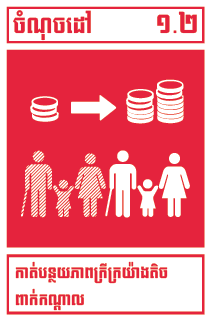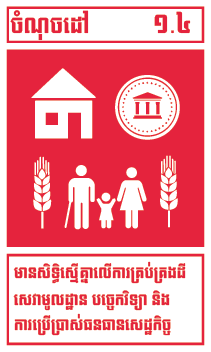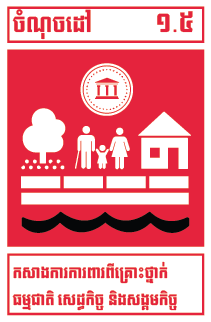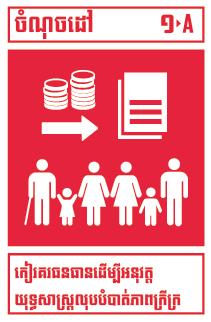គោលដៅអភិវឌ្ឍប្រកបដោយចីរភាពទី១ (គ.អ.ច ១) សំដៅស្វែងរក “ការបញ្ចប់ភាពក្រីក្រគ្រប់ទម្រង់ទាំងអស់” ដោយធានាថាភាពក្រីក្រធ្ងន់ធ្ងរត្រូវបានលុបបំបាត់ ហើយភាពក្រីក្រជារួមត្រូវបានកាត់បន្ថយ ៥០ ភាគរយ។
គោលដៅនេះផ្តល់នូវវិធីសាស្ត្រទូលំទូលាយជាងគោលដៅអភិវឌ្ឍន៍សហស្សវត្សរ៍ (គ.អ.ស.) លើបញ្ហាភាពក្រីក្រ។ គោលដៅនេះផ្តោតលើភាពងាយរងគ្រោះជាមូលដ្ឋានរបស់ប្រជាជនដែលពាក់ព័ន្ធនឹងភាពក្រីក្រទៅនឹងហានិភ័យនានា ដូចជាព្រឹត្តិការណ៍សំខាន់ៗទាក់ទងនឹងអាកាសធាតុ សិទ្ធិស្មើគ្នាចំពោះធនធានសេដ្ឋកិច្ច និងកង្វះលទ្ធភាពទទួលបានភាពជាកម្មសិទ្ធិ និងការគ្រប់គ្រងលើដីធ្លី។
ខណៈពេលដែលភាពក្រីក្រកំពុងតែស្ថិតនៅក្នុងរបៀបវារៈអភិវឌ្ឍន៍អន្ដរជាតិ និងមានការរីកចម្រើនគួរឱ្យកត់សម្គាល់នាប៉ុន្មានឆ្នាំថ្មីៗនេះ ការងារជាច្រើននៅតែចាំបាច់។ របៀបវារៈឆ្នាំ២០១៥ និងគោលដៅអភិវឌ្ឍន៍សហស្សវត្សរ៍បានធ្វើឱ្យភាពក្រីក្រមានភាពប្រសើរឡើងគួរឱ្យកត់សម្គាល់ ដោយបានកាត់បន្ថយជាងពាក់កណ្តាលនៃចំនួនប្រជាជនដែលរស់នៅក្នុងភាពក្រីក្រធ្ងន់ធ្ងរ។ ទោះបីជាយ៉ាងណា ៤៦ ភាគរយនៃកម្មករទាំងអស់នៅតំបន់អាស៊ីអាគ្នេយ៍កំពុងធ្វើការក្នុងស្ថានភាពងាយរងគ្រោះ ដោយពួកគេកម្រនឹងទទួលបានអត្ថប្រយោជន៍ដែលទាក់ទងនឹងការងារសមរម្យ ហើយជារឿយៗងាយនឹងធ្លាក់ចូលទៅក្នុងភាពក្រីក្រធ្ងន់ធ្ងរវិញ។ នៅឆ្នាំ២០១៧ គេប៉ាន់ប្រមាណថា កម្មករជិត ១,៤ ពាន់លាននាក់មានការងារដែលងាយរងគ្រោះ។1 នៅតំបន់អាស៊ីអាគ្នេយ៍ ការងារដែលងាយរងគ្រោះបន្តកើតមាន ជាទូទៅនៅក្នុងចំណោមស្ត្រីច្រើនជាងបុរស ដែលអត្រាការងារងាយរងគ្រោះក្នុងចំណោមស្ត្រី គឺខ្ពស់ជាងអត្រាបុរសចំនួន ១០ ភាគរយ។2 អាស្រ័យហេតុនេះទើបសហគមន៍អន្តរជាតិបានលើកយកបញ្ហានេះជាបញ្ហាចម្បងក្នុងរបៀបវារៈឆ្នាំ២០៣០ ហើយជម្រុញបណ្តាប្រទេសទាំងឡាយឱ្យមានសកម្មភាពបន្ថែមទៀត។
គោលដៅនេះមានចំណុចដៅដែលជាប់ទាក់ទងគ្នាចំនួន ៧ ដូចខាងក្រោម3៖
 |  |  |
|
 |  |  |  |
ការផ្លាស់ប្តូរពីគោលដៅអភិវឌ្ឍន៍សហស្សវត្សរ៍ ទៅកាន់គោលដៅអភិវឌ្ឍប្រកបដោយចីរភាពទី១ នៅក្នុងប្រទេសកម្ពុជា
ភាពក្រីក្រត្រូវបានលើកយកមកពិភាក្សានៅក្នុងគោលដៅអភិវឌ្ឍន៍សហស្សវត្សរ៍ទី១ (គ.អ.ស. ទី១) ដែលភាពក្រីក្រភាគច្រើនគឺពាក់ព័ន្ធនឹងភាពអត់ឃ្លាន។ ក្នុងចំណោមចំណុចដៅ ៣ នៃគោលដៅអភិវឌ្ឍន៍សហស្សវត្សរ៍ទី១ មានចំណុចដៅចំនួន ២ ដំបូងដែលផ្តោតជាពិសេសលើភាពក្រីក្រ៖ ក) កាត់បន្ថយសមាមាត្រនៃប្រជាជនដែលមានចំណូលប្រចាំថ្ងៃតិចជាង ១,២៥ ដុល្លារ ខ) ដើម្បីទទួលបានការងារពេញលេញ និងមានផលិតភាពក៏ដូចជាការងារសមរម្យសម្រាប់មនុស្សគ្រប់រូប រួមទាំងយុវវ័យ និងស្ត្រី និង គ) កាត់បន្ថយ សមាមាត្រនៃមនុស្សដែលទទួលរងពីភាពអត់ឃ្លានរវាងឆ្នាំ១៩៩០ និង២០១៥។4
មូលដ្ឋានីយកម្មនៃគោលដៅអភិវឌ្ឍន៍សហស្សវត្សរ៍កម្ពុជាទី១ (គ.អ.ស. ទី១) មានចំណុចដៅចំនួន២ដែលដោះស្រាយលើភាពក្រីក្រ៖
- ចំណុចដៅ A៖ កាត់បន្ថយឱ្យបានពាក់កណ្ដាលសមាមាត្រនៃប្រជាជនរស់នៅក្រោមខ្សែបន្ទាត់ភាពក្រីក្ររបស់ជាតិ។
- ចំណុចដៅ C៖ បង្កើនចំណែកនៃចំណូលរបស់ប្រជាជនក្រីក្របំផុត ២០ ភាគរយ។
វឌ្ឍនភាព គឺមានភាពមិនស្មើគ្នារវាងប្រទេស តំបន់ និងក្រុមប្រជាជន។ លទ្ធផលគឺស្រដៀងគ្នានៅកម្រិតប្រទេសសម្រាប់កម្ពុជា។ ការពិនិត្យឡើងវិញនៃគោលដៅអភិវឌ្ឍន៍សហសវត្សរ៍កម្ពុជាបានឆ្លុះបញ្ចាំងពីការរីកចម្រើនមិនស្មើគ្នាយ៉ាងខ្ពស់ នៅថ្នាក់ក្រោមជាតិ និងនៅទូទាំងក្រុមប្រជាជន។ ខណៈដែលគោលដៅ A ត្រូវបានបំពេញយ៉ាងពេញលេញ គោលដៅ C បានបង្ហាញពីដំណើរការមិនល្អ។ ទោះបីជាសមភាពនៃប្រាក់ចំណូលមានការប្រសើរឡើងក្ដី ក៏ការកែលម្អនេះនៅទាបជាងគោលដៅដែលបានកំណត់ ដោយសារតែភាពខុសគ្នារវាងខេត្ត និងខេត្ត។
ប្រេវ៉ាឡង់នៃភាពក្រីក្រ
ការផ្លាស់ប្តូរពីគោលដៅអភិវឌ្ឍន៍សហស្សវត្សរ៍ទៅកាន់គោលដៅអភិវឌ្ឍប្រកបដោយចីរភាព កំពុងឆ្លុះបញ្ចាំងពីការផ្លាស់ប្តូរដ៏សំខាន់នៃវិធីសាស្ត្រចំនួន ២។ ជាដំបូង របៀបវារៈថ្មីឆ្នាំ២០៣០ ធ្វើឱ្យមានភាពខុសគ្នាយ៉ាងច្បាស់រវាងភាពក្រីក្រ និងភាពអត់ឃ្លាន ដោយការបង្កើតគោលដៅតែមួយសម្រាប់ការផ្លាស់ប្តូរនេះ។ ទី២ វិធីសាស្ត្រទូលំទូលាយជាងមុនត្រូវបានអនុម័ត។ គោលដៅអភិវឌ្ឍប្រកបដោយចីរភាពទី១ បង្ហាញពីកត្តាមួយចំនួនទៀតដែលរារាំងដល់វឌ្ឍនភាពនេះ ដូចជាភាពងាយរងគ្រោះចំពោះហានិភ័យនានា និងចំនួនប្រជាជនជាច្រើន ដែលកំពុងមានការងារងាយរងគ្រោះ។
គោលដៅអភិវឌ្ឍប្រកបដោយចីរភាពទី១ អំពាវនាវឱ្យមានភាពស្មើគ្នារវាងបុរស និងស្ត្រីចំពោះលទ្ធភាពទទួលបាននូវសេវាកម្ម ភាពជាម្ចាស់ និងការគ្រប់គ្រងដី និងកម្មសិទ្ធិផ្សេងទៀត មរតក ធនធានធម្មជាតិ ក៏ដូចជាសេវាហិរញ្ញវត្ថុ រួមទាំងមីក្រូហិរញ្ញវត្ថុជាដើម។ នេះពាក់ព័ន្ធនឹងការលើកកម្ពស់កំណើនសេដ្ឋកិច្ចប្រកបដោយបរិយាបន្ន ដើម្បីផ្តល់ការងារដែលមានចីរភាព និងនាំមកនូវសមភាព។ ប្រព័ន្ធគាំពារសង្គមចាំបាច់ត្រូវអនុវត្ត ដើម្បីជួយកាត់បន្ថយផលប៉ះពាល់របស់បណ្តាប្រទេសដែលងាយរងគ្រោះនឹងគ្រោះមហន្តរាយ និងផ្តល់ការគាំទ្រចំពោះហានិភ័យផ្នែកសេដ្ឋកិច្ច។ ប្រព័ន្ធទាំងនេះនឹងជួយពង្រឹងការឆ្លើយតបរបស់ប្រជាជនដែលរងផលប៉ះពាល់ ដោយសារការខាតបង់សេដ្ឋកិច្ចដែលមិនបានរំពឹងទុកក្នុងកំឡុងពេលមានគ្រោះមហន្តរាយ ហើយទីបំផុតនឹងជួយបញ្ចប់ភាពក្រីក្រធ្ងន់ធ្ងរ នៅតាមតំបន់ក្រីក្របំផុត។5
ផ្ទុយពីគោលដៅអភិវឌ្ឍន៍សហស្សវត្សរ៍ របៀបវារៈឆ្នាំ២០៣០ មានធាតុផ្សំរួមបញ្ចូលគ្នា និងមិនអាចបំបែកពីគ្នាបានទេ ពីព្រោះគោលដៅទាំងនោះ គឺមានបំណងបំពេញបន្ថែម និងពង្រឹងគ្នាទៅវិញទៅមក។ គោលដៅអភិវឌ្ឍប្រកបដោយចីរភាពទី១ មានតំណភ្ជាប់យ៉ាងរឹងមាំជាមួយគោលដៅទី២ គ្រោះអត់ឃ្លានស្មើសូន្យ គោលដៅទី៣ សុខភាពល្អ និងសុខុមាលភាព គោលដៅទី៥ សមភាពយេនឌ័រ គោលដៅទី៦ ទឹកស្អាត និងអនាម័យ និងគោលដៅទី១០ កាត់បន្ថយវិសមភាព។
ការធ្វើមូលដ្ឋានីយកម្មគោលដៅទី១ នៅក្នុងប្រទេសកម្ពុជា
ចំណុចដៅ និងសូចនាករ
បើទោះបីជាមានកំណើនសេដ្ឋកិច្ចខ្ពស់ និងការកាត់បន្ថយភាពក្រីក្រជាបន្តបន្ទាប់ក្នុងរយៈពេលជាងពីរទសវត្សរ៍ចុងក្រោយក៏ដោយ ការងារងាយរងគ្រោះនៅតែជាបញ្ហានៃភាពក្រីក្រដ៏ធំនៅកម្ពុជា។ គោលដៅជាតិសម្រាប់គោលដៅអភិវឌ្ឍន៍សហស្សវត្សរ៍កម្ពុជាទី១ ក្នុងការបង្កើនចំណែកនៃចំណូលរបស់ប្រជាជនក្រីក្របំផុត ២០ ភាគរយ មិនត្រូវបានបំពេញទេ។ នៅក្នុងសន្ទស្សន៍សកលពីភាពក្រីក្រពហុសមាសភាគឆ្នាំ២០១៧ របស់កម្មវិធីអភិវឌ្ឍន៍សហប្រជាជាតិ ប្រទេសកម្ពុជាឈរលំដាប់ទី៦៤ ក្នុងចំណោម ១០៤ ប្រទេស ដែលត្រូវបានវាយតម្លៃដែលចំណាត់ថ្នាក់នេះគឺទាបជាងប្រទេសថៃ (លំដាប់ទី១៣) វៀតណាម (លំដាប់ទី៣៩) និងឡាវ (លំដាប់ទី៥៨) ប៉ុន្តែកម្ពុជាមានភាពប្រសើរជាងប្រទេសមីយ៉ាន់ម៉ាបន្តិច (លំដាប់ទី៦៦)។6
រាជរដ្ឋាភិបាលកម្ពុជាបានប្រឹងប្រែងបង្កើត និងអនុវត្តគោលនយោបាយសង្គមផ្សេងៗ ដើម្បីធានាថាប្រជាជនក្រីក្រ និងជនងាយរងគ្រោះទទួលបានការគាំទ្រ តាមរយៈការបង្កើតមណ្ឌលកុមារកំព្រា សម្ភារៈបរិក្ខារសម្រាប់ជនពិការ មណ្ឌលថែទាំមាតា និងទារកទើបនឹងកើត សេវាសុខភាព ផ្ដល់ប្រាក់ឧបត្ថម្ភធនដល់ប្រជាជនក្រីក្រដែលត្រូវការការព្យាបាល ឬសេវាសម្រាលកូន ការអប់រំកម្រិតបឋមសិក្សា និងមធ្យមសិក្សាដោយឥតគិតថ្លៃ។ល។ ក្រៅពីនេះរាជរដ្ឋាភិបាលបានបង្កើតបេឡាជាតិសន្តិសុខសង្គមសម្រាប់មន្ត្រីរាជការស៊ីវិល (ប.ជ.ស) បេឡាជាតិរបបសន្តិសុខសង្គម (ប.ស.ស) បេឡាជាតិអតីតយុទ្ធជន (ប.ជ.អ) និងមូលនិធិជនពិការ (ម.ជ.ព) ដើម្បីធានាបាននូវស្ថេរភាពនៃប្រាក់ចំណូលសម្រាប់ប្រជាពលរដ្ឋ តាមរយៈប្រាក់សោធននិវត្តន៍ សេវាសុខភាព ប្រាក់ឧបត្ថម្ភសម្រាប់គ្រោះថ្នាក់ការងារ ប្រាក់ឧបត្ថម្ភពិការភាព និងប្រាក់ឧបត្ថម្ភផ្សេងៗទៀត (ការត្រួតពិនិត្យថ្នាក់ជាតិដោយស្ម័គ្រចិត្ត (VNR) ឆ្នាំ២០១៩ នៃការអនុវត្តរបៀបវារៈឆ្នាំ២០៣០ ផ្នែកទី៤៖ វឌ្ឍនភាពលើគោលដៅ និងចំណុចដៅ)។ សកម្មភាពទាំងនេះសមស្របទៅនឹងគោលនយោបាយកាត់បន្ថយភាពក្រីក្រ និងគោលនយោបាយអភិវឌ្ឍន៍សេដ្ឋកិច្ចសង្គមរបស់រាជរដ្ឋាភិបាលដែលបានដាក់បញ្ចូលរួចហើយ នៅក្នុងគោលនយោបាយសំខាន់ៗដទៃទៀតមានដូចជាយុទ្ធសាស្ត្រចតុកោណ និងផែនការយុទ្ធសាស្ត្រអភិវឌ្ឍន៍ជាតិ (ផ.យ.អ.ជ) ជាដើម។7
តារាងទី១៖ ការផ្លាស់ប្ដូរបរិបទពីគោលដៅអភិវឌ្ឍន៍សហសវត្សរ៍ទី ១ ទៅកាន់គោលដៅអភិវឌ្ឍន៍សហស្សវត្សរ៍កម្ពុជាទី១8
| ចំណុចដៅនៃគ.អ.ច.ក | សូចនាករនៃ គ.អ.ច.ក | ឯកតា | ឆ្នាំគោល(២០១៥) | ២០២០-២០២១ | ២០២៥ | ២០៣០ | រយៈពេលត្រួតពិនិត្យ |
| ១.២ កាត់បន្ថយយ៉ាងតិចពាក់កណ្ដាលនូវសមាមាត្រនៃបុរស ស្ដ្រី និងកុមារគ្រប់អាយុដែលរស់នៅក្នុងភាពក្រីក្រ គ្រប់សមាសភាពដោយផ្អែកលើនិយមន័យរបស់កម្ពុជា នៅត្រឹមឆ្នាំ២០៣០ | ១.២.១ សមាមាត្រនៃប្រជាជនកម្ពុជារស់នៅក្រោមខ្សែបន្ទាត់ភាពក្រីក្រជាតិ បែងចែកតាមភេទ អាយុ និងតំបន់ភូមិសាស្ត្រ | ២ ឆ្នាំ | |||||
| ១.២.១.១ សមាមាត្រនៃប្រជាជនកម្ពុជារស់នៅក្រោមខ្សែបន្ទាត់ភាពក្រីក្រជាតិ | % | ១៣,៥០ (២០១៤) | ១០,៥០ | ៨,៥០ | ៦,០០ | ២ ឆ្នាំ | |
| ១.២.១.២ សមាមាត្រនៃប្រជាជនកម្ពុជានៅរាជធានីភ្នំពេញ ដែលរស់នៅក្រោមខ្សែបន្ទាត់ភាពក្រីក្រជាតិ | % | ១២,៩០ (២០១៤) | ១៤,៧០ | ១១,៧០ | ៩,០០ | រៀងរាល់ឆ្នាំ | |
| ១.២.១.៣ សមាមាត្រនៃប្រជាជនកម្ពុជានៅតំបន់ទីប្រជុំជន ដែលរស់នៅក្រោមខ្សែបន្ទាត់ភាពក្រីក្រជាតិ | % | ១២,៩០ (២០១៤) | ១០,៥០ | ៨,៥០ | ៦,០០ | ២ ឆ្នាំ | |
| ១.២.១.៤ សមាមាត្រនៃប្រជាជនកម្ពុជានៅតំបន់ជនបទ ដែលរស់នៅក្រោមខ្សែបន្ទាត់ភាពក្រីក្រជាតិ | % | ១២,៥០ (២០១៤) | ១០,៥០ | ៨,៨០ | ៦,៣០ | រៀងរាល់ឆ្នាំ | |
| ១.២.១.៥ សមាមាត្រនៃកុមារកម្ពុជារស់នៅក្រោមខ្សែបន្ទាត់ភាពក្រីក្រជាតិ | % | ២២,២(២០១៤) | ១៨,០០ | ១៤,៨ | ១១,១០ | ២ ឆ្នាំ | |
| ១.២.២ សមាមាត្រកុមារ ដែលរស់នៅក្នុងភាពក្រីក្រគ្រប់សមាសភាព ផ្អែកតាមនិយមន័យរបស់ជាតិ | % | ៥០,៧ (២០១៤) | ៤២,៣ | ៣៣,៨ | ២៥,៤ | ៥ ឆ្នាំ | |
| ១.៣ អនុវត្តប្រព័ន្ធជាតិគាំពារសង្គម និងវិធានការផ្សេងៗទៀតឱ្យបានទូទាំងប្រទេស និងសម្រេចឱ្យបានភាគច្រើននូវភាពគ្របដណ្ដប់នៃប្រព័ន្ធនេះដល់ប្រជាជនក្រីក្រ និងប្រជាជនងាយរងគ្រោះ នៅត្រឹមឆ្នាំ២០៣០ | ១.៣.១ សមាមាត្រនៃប្រជាជនកម្ពុជា បែងចែកតាមភេទ កុមារ ប្រជាជនគ្មានការងារធ្វើ ជនវ័យចាស់ ជនបាត់បង់សមត្ថភាពពលកម្ម (ជនពិការ) ស្ត្រីមានផ្ទៃពោះ ទារកទើបនឹងកើត ជនរងគ្រោះអំឡុងពេលបម្រើការងារ ជនក្រីក្រ និងជនងាយរងគ្រោះដែលទទួលបានប្រព័ន្ធគាំពារសង្គម | ||||||
| ១.៣.១.១ សមាមាត្រនៃជនក្រីក្រ និងជនងាយរងគ្រោះដែលទទួលបានសេវាកម្មសង្គ្រោះសង្គម | % | ៣,៧៩ (២០១៧) | ៣,៣២ | ២,៩២ | ២,៥១ | រៀងរាល់ឆ្នាំ | |
| ១.៤ ត្រឹមឆ្នាំ២០៣០ធានាថា បុរស ស្ត្រីគ្រប់រូប ជាពិសេសប្រជាជនក្រីក្រ និងប្រជាជនងាយរងគ្រោះមានសិទ្ធិស្មើគ្នាក្នុងការប្រើប្រាស់ធនធានសេដ្ឋកិច្ច និងក្នុងការទទួលបានសេវាមូលដ្ឋាន ភាពជាម្ចាស់ និងការគ្រប់គ្រងដីនិងកម្មសិទ្ធិផ្សេងទៀត ធនធានធម្មជាតិ បច្ចេកវិទ្យាថ្មីៗសមស្រប និងសេវាហិរញ្ញវត្ថុ រួមទាំងមីក្រូហិរញ្ញវត្ថុ | ១.៤.១ ភាគរយនៃសមាជិកសហគមន៍នេសាទ និងព្រៃឈើ ដែលទទួលបានសិទ្ធិស្របច្បាប់ក្នុងការចូលរួមគ្រប់គ្រងធនធានជលផល និងព្រៃឈើ តាមរយៈការចុះបញ្ជី និងអភិវឌ្ឍសហគមន៍ប្រកបដោយប្រសិទ្ធភាព | % | ៤០,០ (២០១៦) | ៥០,០ | ៦៣,០ | ៨៥,០ | រៀងរាល់ឆ្នាំ |
នៅក្នុងក្របខ័ណ្ឌនៃគោលដៅអភិវឌ្ឍប្រកបដោយចីរភាពកម្ពុជាឆ្នាំ ២០១៦-២០៣០ ដែលបានចេញផ្សាយដោយរាជរដ្ឋាភិបាលកម្ពុជា ការកាត់បន្ថយភាពក្រីក្រនៅតំបន់ជនបទ ក៏ដូចជាការកាត់បន្ថយភាពក្រីក្ររបស់កុមារ គឺជាអាទិភាពកំពូល។ ការពង្រីកនៃអន្តរាគមន៍នឹងពង្រឹងរបៀបវារៈឆ្នាំ២០៣០ ដែលរួមមានការធានាថា ប្រាក់ចំណូលរបស់ប្រជាជនក្រីក្របំផុតនឹងកើនឡើង ២០ ភាគរយ ក្នុងអត្រាលឿនជាងក្រុមដទៃទៀត តាមរយៈការបង្កើនកាលានុវត្តភាពសេដ្ឋកិច្ចដល់ក្រុម និងតំបន់ដែលមានជីវភាពទាបជាងគេ និងការដាក់ចេញនូវវិធានការជំនួយសង្គមដល់ប្រជាជនក្រីក្រ។ ទោះជាយ៉ាងណាក៏ដោយ សកម្មភាពជាក់លាក់សម្រាប់ការអន្តរាគមន៍ទាំងនេះ មិនត្រូវបានរៀបរាប់លម្អិតនៅក្នុងឯកសារនោះទេ។9
កម្មវិធីអភិវឌ្ឍន៍អង្គការសហប្រជាជាតិបានធ្វើការវាយតម្លៃរួមបញ្ចូលគ្នាយ៉ាងឆាប់រហ័ស (RIA) ទៅលើផែនការយុទ្ធសាស្ត្រអភិវឌ្ឍន៍ជាតិឆ្នាំ២០១៤-២០១៨ ទៅលើចំណុចដៅអភិវឌ្ឍន៍ប្រកបដោយចីរភាព។ ខណៈពេលដែលខ្សែបន្ទាត់ក្រីក្ររបស់ជាតិបានបង្ហាញថា ភាពក្រីក្រអាចនឹងថយចុះពី ៣៤,៤ ភាគរយ (ឆ្នាំ២០០៨) មកត្រឹម ១៧,៧ ភាគរយ (ឆ្នាំ២០១២) សន្ទស្សន៍សកលពីភាពក្រីក្រពហុសមាសភាគបានបង្ហាញថា ៣៣ ភាគរយនៃប្រជាជនកម្ពុជានៅតែក្រីក្រក្នុងពហុសមាសភាគ ហើយ ២១,៦ ភាគរយទៀតនៃប្រជាជននៅតែងាយនឹងធ្លាក់ចូលទៅក្នុងភាពក្រីក្រវិញ។10 ផែនការយុទ្ធសាស្ត្រអភិវឌ្ឍន៍ជាតិឆ្នាំ២០១៤-២០១៨ ត្រួតពិនិត្យលើអត្រាភាពក្រីក្រ ចំនួនស្ត្រីនៅក្នុងកម្លាំងពលកម្ម និងឥណទានមីក្រូហិរញ្ញប្បទាន ក្នុងចំណោមស្ថាប័នផ្សេងទៀតដែលពាក់ព័ន្ធយ៉ាងខ្លាំងនឹងគោលដៅអភិវឌ្ឍប្រកបដោយចីរភាពកម្ពុជាទី១។
មធ្យោបាយនៃការអនុវត្ត និងការត្រួតពិនិត្យគោលដៅអភិវឌ្ឍប្រកបដោយចីរភាពទី១ នៅក្នុងប្រទេសកម្ពុជា
ការសម្របសម្រួលចំណុចដៅនៃគោលដៅអភិវឌ្ឍប្រកបដោយចីរភាពកម្ពុជាទី១ ត្រូវបានចាត់តាំងទៅក្រសួង និងស្ថាប័នរដ្ឋាភិបាលនានា។ ក្រសួងសង្គមកិច្ច អតីតយុទ្ធជន និងយុវនីតិសម្បទា ទទួលខុសត្រូវលើសូចនាករ ១.២.១ ដែលទាក់ទងនឹងការផ្តល់ជំនួយសង្គមដល់ជនងាយរងគ្រោះបំផុត។ ក្រសួងកសិកម្ម រុក្ខាប្រមាញ់ និងនេសាទ ទទួលខុសត្រូវលើសូចនាករ ១.៤.១ ដែលទាក់ទងនឹងកម្មសិទ្ធិដីធ្លី។ ក្រសួងនានានៃព្រះរាជាណាចក្រកម្ពុជាទទួលខុសត្រូវជាចម្បងលើសូចនាករទាំងអស់ ដែលគាំទ្រគោលដៅ ១.២ ដោយជម្រុញឱ្យមានការកាត់បន្ថយប្រកបដោយបរិយាបន្នចំពោះភាពក្រីក្រពហុសមាសភាគ។11
រាជរដ្ឋាភិបាលកម្ពុជាបានដាក់ចេញនូវគោលបំណងដូចខាងក្រោមសម្រាប់គោលដៅអភិវឌ្ឍប្រកបដោយចីរភាពកម្ពុជាទី១ ដែលនឹងត្រូវអនុវត្តនៅឆ្នាំ២០៣០12៖
កាត់បន្ថយសមាមាត្រនៃប្រជាជនរស់នៅក្រោមខ្សែបន្ទាត់ភាពក្រីក្រជាតិពី ១៣,៥០ ភាគរយ នៅក្នុងឆ្នាំ២០១៤ ទៅ ៦ ភាគរយ
កាត់បន្ថយសមាមាត្រនៃប្រជាជននៅរាជធានីភ្នំពេញដែលរស់នៅក្រោមខ្សែបន្ទាត់ភាពក្រីក្រជាតិពី ១២,៩០ ភាគរយ នៅក្នុងឆ្នាំ២០១៤ ទៅ ៩ ភាគរយ
កាត់បន្ថយសមាមាត្រនៃប្រជាជននៅតំបន់ទីប្រជុំជនដែលរស់នៅក្រោមខ្សែបន្ទាត់ភាពក្រីក្រជាតិពី ១២,៩០ ភាគរយ នៅក្នុងឆ្នាំ២០១៤ ទៅ ៦ ភាគរយ
កាត់បន្ថយសមាមាត្រនៃប្រជាជននៅតំបន់ទីជនបទដែលរស់នៅក្រោមខ្សែបន្ទាត់ភាពក្រីក្រជាតិពី ១២,៥០ ភាគរយ នៅក្នុងឆ្នាំ២០១៤ ទៅ ៦,៣០ ភាគរយ
កាត់បន្ថយសមាមាត្រនៃកុមាររស់នៅក្រោមខ្សែបន្ទាត់ភាពក្រីក្រជាតិពីការប៉ាន់ស្មាន ២២,២០ ភាគរយ នៅក្នុងឆ្នាំ២០១៥ ដល់ ១១,១០ ភាគរយ
កាត់បន្ថយសមាមាត្រនៃកុមារដែលរស់នៅក្នុងភាពក្រីក្រ ដែលបានវាស់វែងដោយវិមាត្រជាច្រើនពី ៥០,៧០ ភាគរយ ក្នុងឆ្នាំ២០១៤ មកត្រឹម ២៥,៤០ភាគរយ
- បង្កើនភាគរយនៃសមាជិកសរុបនៃសហគមន៍នេសាទ និងសហគមន៍ព្រៃឈើដែលបានចុះបញ្ជី ដោយមានសិទ្ធិកាន់កាប់ក្នុងការគ្រប់គ្រងធនធានពី ៤០ ភាគរយក្នុងឆ្នាំ២០១៦ រហូតដល់ ៨៥ ភាគរយ
គោលដៅអភិវឌ្ឍប្រកបដោយចីរភាពកម្ពុជាទី១ នឹងត្រូវបានត្រួតពិនិត្យជាទៀងទាត់ដោយធ្វើជារៀងរាល់ឆ្នាំ ឬរៀងរាល់ ២ ឆ្នាំម្តង អាស្រ័យលើសូចនាករ។ ការប្រមូលទិន្នន័យចាំបាច់នឹងតម្រូវឱ្យមានការខិតខំរួមគ្នារវាងអ្នកពាក់ព័ន្ធជាច្រើន។ ក្រសួងផែនការ ក្រសួងសង្គមកិច្ច អតីតយុទ្ធជន និងយុវនីតិសម្បទា និងក្រសួងកសិកម្ម រុក្ខាប្រមាញ់ និងនេសាទនឹងប្រមូលទិន្នន័យសម្រាប់អត្រាប្រេវ៉ាឡង់នៃសូចនាករទាំងនេះ។ អង្គការមិនមែនរដ្ឋាភិបាល និងដៃគូនឹងធ្វើការវាយតម្លៃរៀងៗខ្លួនអំពីគម្រោងរបស់ពួកគេដែលនឹងផ្តល់ព័ត៌មានបន្ថែម និងលម្អិត។13
ប្រធានបទពាក់ព័ន្ធ
ឯកសារយោង
- 1. អង្គការពលកម្មអន្តរជាតិ ឆ្នាំ២០១៨. «ការងារ និងទស្សនវិស័យសង្គមពិភពលោក៖ និន្នាការឆ្នាំ ២០១៨». ចូលអានថ្ងៃទី២៥ ខែកក្កដា ឆ្នាំ២០១៩។
- 2. ដូចឯកសារយោងខាងលើ។
- 3. អង្គការទិន្នន័យអំពីការអភិវឌ្ឍ (អូឌីស៊ី). «គោលដៅទី២ គ្រោះអត់ឃ្លានស្មើសូន្យ» ចូលអានថ្ងៃទី១៥ ខែកក្កដា ឆ្នាំ២០១៩។
- 4. អង្គការសហប្រជាជាតិ ឆ្នាំ២០១៥. «របាយការណ៍គោលដៅអភិវឌ្ឍន៍សហស្សវត្សរ៍ឆ្នាំ ២០១៥». ចូលអានថ្ងៃទី២៧ ខែកក្កដា ឆ្នាំ២០១៩។
- 5. អង្គការសហប្រជាជាតិ. «គោលដៅទី១ ពុំមានភាពក្រីក្រ». ចូលអានថ្ងៃទី ២៥ ខែកក្កដា ឆ្នាំ២០១៩។
- 6. កម្មវិធីអភិវឌ្ឍន៍សហប្រជាជាតិ ឆ្នាំ២០១៧. «សន្ទស្សន៍សកលពីភាពក្រីក្រពហុសមាសភាគ៖ ប្រទេសកម្ពុជា». ចូលអានថ្ងៃទី ២៥ ខែកក្កដា ឆ្នាំ២០១៩។
- 7. រាជរដ្ឋាភិបាលកម្ពុជា. «គោលដៅអភិវឌ្ឍន៍សហស្សវត្សរ៍កម្ពុជា». ចូលអានថ្ងៃទី១៣ ខែកក្កដា ឆ្នាំ២០១៩។
- 8. រាជរដ្ឋាភិបាលកម្ពុជា ឆ្នាំ២០១៨. «ក្របខ័ណ្ឌគោលដៅអភិវឌ្ឍប្រកបដោយចីរភាពកម្ពុជា ឆ្នាំ២០១៦-២០៣០». ចូលអានថ្ងៃទី១៣ ខែកក្កដា ឆ្នាំ២០១៩។
- 9. ដូចឯកសារយោងខាងលើ។
- 10. កម្មវិធីអភិវឌ្ឍន៍អង្គការសហប្រជាជាតិ (UNDP). «ការវាយតម្លៃរួមបញ្ចូលគ្នាឆាប់រហ័ស - គោលដៅអភិវឌ្ឍប្រកបដោយចីរភាពនៅកម្ពុជា». ចូលអានថ្ងៃទី១២ ខែកក្កដា ឆ្នាំ២០១៩។
- 11. រាជរដ្ឋាភិបាលកម្ពុជា ឆ្នាំ២០១៨. «ក្របខ័ណ្ឌគោលដៅអភិវឌ្ឍកម្ពុជាប្រកបដោយចីរភាព ២០១៦-២០៣០». ចូលអានថ្ងៃទី២៥ ខែកក្កដា ឆ្នាំ២០១៩។
- 12. ដូចឯកសារយោងខាងលើ។
- 13. ដូចឯកសារយោងខាងលើ។

